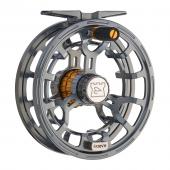Hi-Viz Griffith's Gnat
Winter in Montana offers some tremendous opportunities for fly-fishing. What many anglers do not know, as they look out their front windows on a Sunday afternoon at steadily falling snowflakes, is that eight- to 18-inch trout are sipping clusters of midges in soft, slowly moving eddies on the local rivers.
A favorite pattern for this situation, and one that has been around for years, is the Griffith’s Gnat. This is a fuzzy little fly that’s easy to tie, and given the right size and conditions, easy for fish to see. However, in this day of highly visible synthetic materials, I think it’s important to add a little day-glo to the old favorite.
To tie the Gnat, begin with a light wire dry fly hook in size 14-20. With black 8/0 thread, secure a high-quality grizzly hackle fiber to the shank of the hook, just above the bend, with the tip pointed off the back. Trim the stem, and move the thread near the eye. Secure a clump of highly visible antron or poly-yarn, and then wrap it to create a parachute-style post. Leave it long until the fly is finished.
Move the thread back to the tie-in point of the hackle. Tie in three strands of fuzzy peacock herl. Move the thread to the eye again, and palmer the herl. Tie off near the eye and trim. Palmer the grizzly hackle to the same point, tie off, and trim.
Now weave the thread back through the hackle to the rear, and then back to the eye. Whip-finish here, apply cement, and trim the thread. You may now trim the poly-yarn to a suitable length. I hold that the shorter, the better. If the post is too long, the fly might twist lighter tippets.
This is an easy pattern to tie, and the fishing results can be amazing. In the larger sizes, I like to use the Gnat as a strike indicator fly. A #14 Gnat will suspend a #18 midge larva effectively, and oftentimes the trout and whitefish will try to eat the Gnat instead of the larva. I like to use this technique when I can’t see obvious surface feeders, or if the fish are feeding just below the surface, but not breaking the film.
When the trout are feeding on individual midges, or clusters of mating midges, there’s no substitute for the Griffith’s Gnat. I find the smaller #20 size works well on the spring creeks in Paradise Valley, whereas the #14-#18 are sufficient for sipping heads on the bigger rivers. Although trout might feed on midges in the riffles, I have a hard time seeing them there. Typically on the larger rivers, I find sippers in the soft shoreline eddies.
Although the fishable days in the winter can be few and too far between, when they happen, have a range of highly visible Griffith’s Gnats. It doubles as a midge cluster pattern as well as a strike indicator when using midges. Although effective all year, this fly excels during the winter.
Ingredients:
Hook: Dai-Riki 305 or 310 (straight eye)
Thread: Black 8/0 Uni-thread
Hi-Viz Post: Poly yarn, Z-Lon, or equivalent in red, orange, lime, or even black
Body: Peacock herl
Hackle: High-quality grizzly hackle










